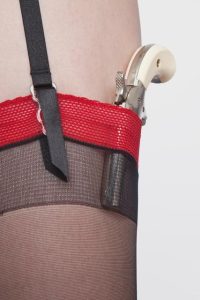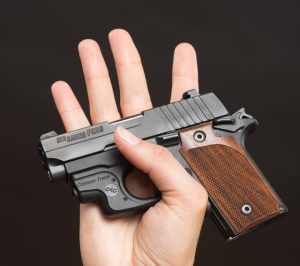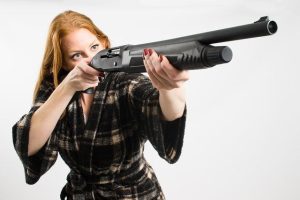There’s no shortage of self-defense gun myths being passed around the range. Some myths are mouthed by the uninformed, other by trainers who should know better. Here are five self-defense myths that you should ignore when the guy or gal in the next lane recites and run from any trainer who endorses them.
Five Self-Defense Gun Myths
You should carry a self-defense pistol with an empty chamber.
This is touted as being a much safer way to carry, as there is zero chance of a negligent discharge. As far as that goes, it is completely true. However, the most likely place for a manual of arms error is a high-stress, quick slide-rack attempt. By carrying an unchambered gun, you have effectively disarmed yourself—unless everything goes right.

Never ever carry a firearm with an unloaded chamber!
This additional step slows down and complicates bringing the gun into action. When fractions of a second may count, at least one second has been added to the process, and a fine motor skill has also been introduced. Not to mention you are assuming unfettered use of both hands. Quite often one hand is required to provide standoff distance for the draw. In my estimation, empty chamber carry is not a recipe for success.
Empty gun carry is a great idea—as long as you don’t leave the house. By limiting yourself to the living room, you can practice carrying and drawing your gun without the risk of an accident. Going out in the wild unchambered is only slightly better than going unarmed. You create the perception of safety, but the reality is likely quite different.
Self-defense calibers can never start with a number lower than 4.
In no way am I knocking .45 ACP, .44 Magnum, .41 Special, .40 S&W, or their brethren. In theory, each of these rounds has a great place in the self-defense arsenal. On the other end, the .22 LR and .22 Magnum are far from optimal, but they are that spitting profanities and throwing cups of coffee from Starbucks.

It is a self-defense myth that a gun for personal protection is useless unless the caliber begins with a 4. Your primary weapon may be a larger caliber but a small caliber conceals easier.
People’s’ ability to handle recoil vary. This may be due to arthritis, another malady or God-given ability. It may simply be that the shooter’s hand can’t properly manage the grip of a gun chambered in .4x or bigger. The best gun for self-defense is the one you can control—in the largest caliber you can make quick follow-up shots with.
As a side note, I once had a conversation with Bill Wilson of Wilson Combat. After years of competing at a top level, Bill looked back at his data. Although he was a top competitor with a 1911 chambered in .45 ACP, his data showed he could run the combat course faster and with better accuracy when he shot it with a 9mm. While the data shows the larger the pea the better chance of a single shot being deadly, you have to hit them. And if you are more accurate with your first shot in a lower caliber… That is something to consider.
For any who tell you that .22 LR, .22 Magnum, .32 ACP, or .380 ACP are worthless as self-defense rounds, ask them to prove it by letting you shoot them as they charge. I think you will find few takers.
However, if they tell you the .25 ACP is worthless for defense, they are probably right.
The sweet spot for doing damage is certainly .380 ACP and up. The sweet spot for minimizing recoil is usually 9mm down. As you may surmise, a significant portion of people end up with a 9mm or .380 ACP as their primary carry gun. Your mileage may vary.
Just carry a revolver. They never malfunction.
It is true that a revolver is not sensitive to primer failure, as pulling the trigger on a dud round will rotate a new round into position. This means a second trigger pull will drop the hammer on a different round. The odds of having back-to-back factory rounds fail is pretty close to the odds of winning the Lotto grand prize.

Revolvers are great for reliability, but the trade off is capacity compared to some guns and speed to a follow-up shot.
For many who refuse to train, this is a comfort. However, revolvers are machines and have all kinds of issues that may render them useless in a self-defense situation. Depending on how tight the tolerances are on the cylinder, an improperly seated primer could stick up enough to lock the cylinder.
A cylinder can get out of timing and not line up the cartridge and the barrel properly. Grit and varnish can gum up the action and create a light hammer fall. The list goes on.
Like with a semi-auto, most of these issues can be prevented with proper gun maintenance. However, those most likely to be told, “Buy a revolver. They never fail,” are the ones least likely to know how to prevent those failures or fix them.
Grab a shotgun, rack the action, and bad guys will run away.
Much like #1, why do you not have a round chambered? The most likely place to have a malfunction is in the reload phase. If your shotgun is already chambered, barring ammo malfunction you will get at least one shot.
I guarantee the discharge of a 12 or 20 gauge will have a greater fear-inducing impulse than merely chambering a shell. Not to mention, the gun is not meant to scare them. It is meant to stop them. If you have the scare mentality, you are very likely to be disarmed and have the gun turned on you. Someone in your house without permission is a very dangerous person, so act accordingly.
Use a shotgun. You don’t even have to aim it.
This is my favorite. Anyone who has ever shot skeet or trap knows quite well how ludicrous this concept is.

Predators intent on doing you harm will not retreat simply from the sounds of a shotgun being cycles. This is a self-defense myth perpetuated by the movie industry.
Depending on the load you are shooting, the shot may not even begin to spread at home defense distances. Almost every 12-gauge buckshot round has a wad. This is a short plastic cup that holds the pellets together when the cartridge is fired. Depending on design, the wad falls away at a certain distance. Prior to that occurring, there is very little spread of the pellet pattern.
In a very shallow cup designed to open and drop away early, this expansion begins at 1 to 3 yards. Other rounds are built with taller, sturdier cups, and the wad may stay with the shot for well beyond 30 yards. Think long-range turkey rounds. Once the wad falls away, a rule of thumb for expansion is a half-inch per yard of travel.
This means at 10 yards, the most expansive patterns will cover roughly 4 to 7 inches. This creates a very powerful hit, assuming you do. But most of us do not have 10-yard/30-foot distances within our houses.
At the more realistic distance of 5 yards (or less), that same shot shell will likely see 2 to 4 inches of spread. If you do not have a wide-spreading wad, the shot column is likely to be just over bore diameter (.729 inch). I am going to suggest that in either case there is a definite need for aiming.
I am also going to suggest patterning your shotgun with a variety of loads. Shoot a paper target at ranges of 2, 4, 7, 10, and 15 yards to see how each load patterns. While you are at it, shoot a pumpkin with 7.5 birdshot to see why that is not the best choice for home defense.
If you think it does a good job on a fresh pumpkin (or cantaloupe), try it again with a pork butt. Spoiler alert: You will see massive superficial damage but very little deep penetration. Penetration is the key to stopping aggression in something more animated than a piece of fruit.
Do you have any favorite self-defense gun myths? Share them in the comment section.
Cocked and Locked is the official content provider of TheBestShootingSite.com. Be sure to also check out: AR-15 Components: A Little More Means a Lot Better.

